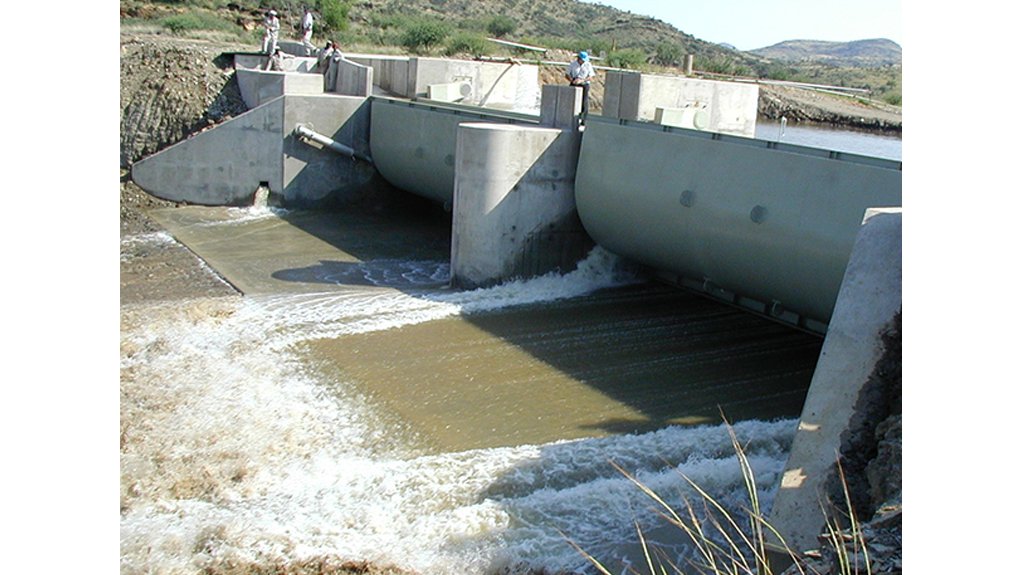Tech solution enhances water security in S Africa


WATER GATE The scour gate developed by Amanziflow allows for the effective flushing of sediment from a dam increasing its storage capacity
The self-automated scour gate is a technology which has been developed and refined by local water engineering contractors Amanziflow Projects to promote water security.
Amanziflow Projects MD Peter Townshend says many projects have been conducted by the company in the Southern African Development Community.
“The installation of a scour gate by Amanziflow Projects generally starts at the design phase, but such a gate can be retrofitted to an existing dam, should the need arise.”
He explains that a scour gate is used when a river and its tributaries move a substantial amount of silt or sediment during floods, which can eventually fill up most of the dam and decrease much of its storage capacity.
The scour gate opens automatically when a flood passes through the dam or weir to pass the sediment-laden water, which is either in suspension or rolling along the riverbed, before the sediment settles out and consolidates. The scour gate automatically closes as the flood recedes to retain the full supply level in the dam or weir.
These scour gates can also be opened manually to sluice out sediment in smaller dams by drawing down the water level to flush the dam and then allowing for it to refill and then repeating the process of flushing to obtain the required result.
The scour gate is used effectively in river offtakes to pumpstations, canals or penstocks to remove sediment, and is a valuable flood-routing gate to redirect floods.
Local Security
“Water storage capacity in South Africa is decreasing when we are an already water-scarce country that suffers from debilitating long droughts, which are usually followed by high-intensity rainfall and extensive flooding,” Townshend points out.
Based on data provided to Amanziflow by the Department of Water and Sanitation (DWS), about 11.5% of South Africa’s design capacity in dams has already been lost to siltation.
Townshend says the expectation is that as much as 20% of South Africa’s dam storage could be lost within the next ten years. This is equivalent to losing the volume of a large dam – which could hold about 100- to 150-million cubic metres – to siltation every year.
“Many dams are almost fully silted and are no longer used as storage dams, with a considerable loss of capital expenditure such as Shongweni and Gilbert Eyles, in KwaZulu-Natal,” he illustrates.
Further, South Africa has an approximate design capacity of 33.6- billion cubic metres of water stored in 575 large reservoirs. This storage is at risk, as demand for water increases and climate change is taking its toll, in the form of extended dry periods and high evaporation, as well as floods which carry large quantities of sediment into the dams
South Africa already uses about 95% of its water resources, which are captured in more that 5 000 registered dams, according to DWS.
There is, therefore, not much water to store in new dams and Townshend suggests that there is little point in constructing new dams.
He adds that a new dam is a large capital cost expenditure in terms of not only the construction of the dam but also the compensation for the loss of land that will be inundated with water and on which the dam will be built. It also has further implications in terms of relocating people and graveyards, as well as inundating fauna and/or flora.
Also, the construction of a dam involves quarrying rock and soils using a large fleet, consequently also adding a pronounced carbon footprint.
“The country has to use its existing dams to try to gain – or regain – extra storage from sedi- ment deposition to meet the growing demand for water,” concludes Townshend.
Article Enquiry
Email Article
Save Article
Feedback
To advertise email advertising@creamermedia.co.za or click here
Comments
Press Office
Announcements
What's On
Subscribe to improve your user experience...
Option 1 (equivalent of R125 a month):
Receive a weekly copy of Creamer Media's Engineering News & Mining Weekly magazine
(print copy for those in South Africa and e-magazine for those outside of South Africa)
Receive daily email newsletters
Access to full search results
Access archive of magazine back copies
Access to Projects in Progress
Access to ONE Research Report of your choice in PDF format
Option 2 (equivalent of R375 a month):
All benefits from Option 1
PLUS
Access to Creamer Media's Research Channel Africa for ALL Research Reports, in PDF format, on various industrial and mining sectors
including Electricity; Water; Energy Transition; Hydrogen; Roads, Rail and Ports; Coal; Gold; Platinum; Battery Metals; etc.
Already a subscriber?
Forgotten your password?
Receive weekly copy of Creamer Media's Engineering News & Mining Weekly magazine (print copy for those in South Africa and e-magazine for those outside of South Africa)
➕
Recieve daily email newsletters
➕
Access to full search results
➕
Access archive of magazine back copies
➕
Access to Projects in Progress
➕
Access to ONE Research Report of your choice in PDF format
RESEARCH CHANNEL AFRICA
R4500 (equivalent of R375 a month)
SUBSCRIBEAll benefits from Option 1
➕
Access to Creamer Media's Research Channel Africa for ALL Research Reports on various industrial and mining sectors, in PDF format, including on:
Electricity
➕
Water
➕
Energy Transition
➕
Hydrogen
➕
Roads, Rail and Ports
➕
Coal
➕
Gold
➕
Platinum
➕
Battery Metals
➕
etc.
Receive all benefits from Option 1 or Option 2 delivered to numerous people at your company
➕
Multiple User names and Passwords for simultaneous log-ins
➕
Intranet integration access to all in your organisation



















